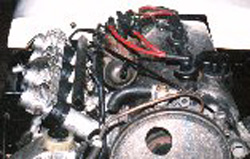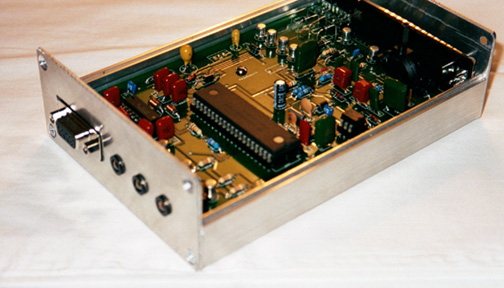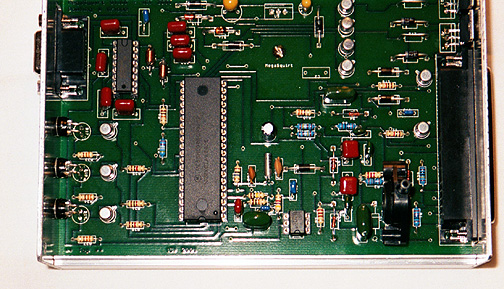 Multisquirt
Multisquirt
Paul Corner is working on putting fuel injection into his
Kindred, waiting on the components from the company below. Paul is using the
following
Bosch injectors with Bing throttle flaps - All sourced from a BMW K100.
Not sure if these are going to be anywhere near the right size, only time
will tell. Allthough, I reckon if the BM is good for 100BHP@8,000 rpm, I
should get 125BHP@6000 rpm without too much trouble.
Bosch injectors with Bing throttle flaps - All sourced from a BMW K100.
Not sure if these are going to be anywhere near the right size, only time
will tell. Allthough, I reckon if the BM is good for 100BHP@8,000 rpm, I
should get 125BHP@6000 rpm without too much trouble.

MegaSquirt
Electronic Fuel Injection Computer By Bowling & Grippo
MegaSquirt Electronic Fuel Injection Computer By Bowling & Grippo

The Most Efficient and Cost-Effective Electronic Fuel Injection Controller in the Universe - and YOU BUILD IT YOURSELF!

MegaSquirt
Electronic Fuel Injection Computer - Features
MegaSquirt Electronic Fuel Injection Computer - Features
Here is a list of some of the features and benefits of the MegaSquirt EFI Controller:
Fuel
calculations based on mathematical equations and physical formulas relating
directly to your vehicle - many other existing systems rely soley on trial-and-error,
estimation or guesswork for fuel delivery.
All of the embedded microprocessor code executed in MegaSquirt was hand-written directly in assembler, not compiled from a high-level language. Working directly in assembler produces the tightest and fastest-executing code possible, even compared to the most efficient C compiler available. The result is that MegaSquirt can provide real-time fuel calculations up to 16,000 RPM!
Electronic Control Unit based on the Motorola MC68HC908GP32 Flash-based microcontroller operating at an internal bus speed of 8 Megahertz (this is bus speed - remember that most microprocessors spec their parts at external crystal speed, which is then divided down by four to yield internal bus speed). Many OEM and popular aftermarket EFI systems use older processor technology (like the MC68HC11 or Z80) which operate at 1 or 2 Mhz internal bus speed. The faster clock speed, coupled with direct assembly-language programming, gives MegaSquirt its power. Additionally, the on-chip Flash memory makes this a true single-chip setup, reducing cost and extending reliability. Also, using Flash technology allows the instant re-programming of constants, enrichments, etc. while the vehicle is running. - the processor can even be re-loaded with other control code using a simple programming interface! The flash can be re-written at least 10,000 times and has a retention duration of 20 years.
Input triggering for injection events is derived from an existing ignition system - either by connection to a conventional Kettering ignition coil (- terminal) or by using the TACH signal available from virtually any OEM or aftermarket ignition system. MegaSquirt uses an on-board opto-isolator to prevent damage due to inductive kickbacks present on ignition coils. Remember, MegaSquirt only controls fuel, not ignition. However, we are currently developing a multiple-coil CDI ignition system with ion-sensing technology which will interface directly to the MegaSquirt system - stay tuned...
Input trigger events (compared to ignition events) can be divided by any number between one and eight (number of cylinders must be evenly divisable by this injection number) - this means that there can be an injection event for every ignition event, or an injection event for every other ignition event (skip one), and so on depending on selection. The user can switch which injection division number to use while the car is running - the system will scale the required fuel amount properly on the fly.
On most batch injection computer systems, every injector will fire for any injection event. Megasquirt has two separate injector drivers (discussed below), and they can be operated in simultaneous mode (both banks fire at the same time) or alternate mode (the banks fire alternately in a ping-pong fashion) - this allows for more flexibility in the end-application.
Two injector drivers are provided to directly operate either saturated or "peak and hold" injectors. The on-board drivers feature a PWM (Pulse Width Modulation) current limit mode which is totally under the control of the user - both PWM application time relative to injection event and duty cycle is adjustable. Virtually any current-limit amount and time can be programmed, allowing this controller to be used with pretty much any injector out there.
MegaSquirt features an on-board Manifold Absolute Pressure (MAP) sensor (Motorola MPX4115). Having the MAP sensor on-board simplifies installation (one just runs a vacuum line to the ECU) and keeps the measurement signal clean, which is very important since the MAP signal is the most critical to proper fuel control. There are other Motorola MPX-series MAP sensors with expanded scales to handle turbo and supercharger applications, like the MPX4250A (this sensor handles 3 to 36 psi, or 20 to 250 KPa) - one can swap this sensor in with hardware change. The MAP sensor is additionally used to obtain the barometric pressure during engine startup, in order to determine a barometric pressure correction factor (explained below).
Coolant and Air-Temperature sensors are inexpensive (roughly US$9.00) GM units readily available from any parts store (GM #12146312). These sensors were been used on practically all GM cars in the 1980's and are easy to find - the same is true for the correct connectors. Also, the inputs to the ECU for the coolant, MAT, and TPS are protected from voltage spikes and noise, and there is both hardware and software low-pass filtering implemented to ensure clean signal measurement. All sensor output voltages (coolant, MAT and MAP) are converted to engineering units (KPa and degrees F) in the embedded software using lookup tables. This means that if another sensor is used, then all one needs to do is generate the transfer function lookup table. These lookup tables are "included" into the embedded source at compile time (barofac.inc, kpafac.inc, and thermfac.inc), thus no change to the embedded control code is required.
MegaSquirt uses an oxygen sensor as feedback for mixture AFR control. MegaSquirt is compatable with single wire (unheated - like Bosch Part Number 12014, used everywhere ) as well as heated units. All parameters that control the feedback (step size and rate, range, trip threshold voltage) are user-controlled. Additionally, since the trip point voltage is user-defined, MegaSquirt is compatable with the DIY-WB (wideband) oxygen sensor board - one simply sets the desired air/fuel ratio trip voltage and you are there.
Air density corrections as a function of manifold air temperatue (MAT) and barometric pressure effects on VE are pre-computed as lookup tables and properly used by the ECU in the fuel calculation. Most aftermarket EFI controllers allow the user to set the air temperature correction - MagaSquirt uses the mathematical equation for air density to generate this correction, so no user intervention is required. More importantly, many aftermarket EFI controllers do not take account the effect of barometric pressure change to volumetric efficiency. This correction comes into play at high altitudes (i.e. low barometric pressures). MegaSquirt uses a lookup table to determine this correction, and is consistent with OEM systems.
All enrichment values (i.e. warmup, acceleration, VE, etc) are calculated as direct percentages and are multipled together (instead of added). This allows one to work directly in percentages, which is easy for people to mentally visualize, with the result that tuning becomes much easier. Adding 25% more fuel is acheived simply by increasing a quantity by 25. A value of 100% represents the nominal required fuel for a cylinder - a number less than this represents an enleanment and a value above this represents an enrichment. Other systems use direct or scaled AFR values or numbers of unknown or wierd units (especially Alpha-N units) - tuning an engine is difficult enough without having to constantly convert crazy numbers to Air-Fuel Ratios.
There is a 64-point Volumetric Efficiency (VE) table, organized as a conventional grid eight RPM points vs. eight MAP points. The entries in the VE table are in direct percentages, so that a number of 80 means that the VE is 80%. You can take direct dyno VE values and plug them right in without any conversions. Additionally, specific RPM and MAP range points are adjustable by the end user, a very nice feature. No, there are not hundreds of VE grid points, only 64 - this allows for plenty of control of the engine without having to fill in a bunch of grid points with redundant values. A 16x16-point table (or higher) used by some other units is not a feature, but a pain, especially during tuning, because all 256 slots need to be entered. In addition, the value of VE is *correctly* interpolated between grid points and is truncated to the grid edge points when outside of the table - this is not the case with other systems on the market.
There is an output control signal (current sink up to 500ma) designed to drive an idle bypass solenoid (open/close solenoid, not a stepper), which allows the addition of more air at idle during warmup. The activation/deactivation temperature is set by the user.
A relay drive circuit (up to 500 ma) is provided to control power to the fuel pump. Signal is active while the engine is cranking or running, and will deactivate 2 seconds after the last ignition event.
A nice feature on the MegaSquirt controller not found on other systems are three indicator LEDs which reflect the current operating mode of the controller. The first LED pulses whenever there is an injection event, and the glow duration follows the actual injector pulsewidth. The second LED is active whenever the ECU is in a warmup enrichment state (i.e not at 100%). The third LED indicates an acceleration enrichment, and is active during the entire duration of the event. Extremely useful, especially during installation and debug. Flashing lights also look "cool", particularly when you show off your controller to others.
The best feature of MegaSquirt is that you build it yourself! Since you assemble the controller, and all information about the design is available to you, you are able to troubleshoot the board if a problem arises, and, in almost all cases, repair the unit yourself. The system as it exists today is a complete turn-key solution: solder it together, install in the vehicle or boat, tune, and use. The complete source code is available on this site for those who want to understand or even modify the control algorithms - one can convert this board to control nitrous, alcohol, methanol, LPG, etc. - there is really no limit. Why purchase a $1,000 plus unit when you can build one yourself?
MegaSquirt
Electronic Fuel Injection Computer - FAQ
MegaSquirt Electronic Fuel Injection Computer - FAQ
Q:
What is MegaSqurt?
A:
MegaSquirt is an Experimental Electronic Fuel Injector Controller for
Internal Combustion engines. Its main goal was to create a simple fuel-only
controller that could be easily reproduced with cost-effective components.
Q:
How does it work?
A:
MegaSquirt takes reference pulses form an existing ignition system
(TACH signal), along with manifold air pressure, coolant and intake
air temperature, and oxygen content (exhaust), and generates electronic
fuel injector pulses (two drive channels). MegaSquirt also controls
the fuel pump and fast-idle solenoid.
Q:
How does it calculate the feul requirement for an engine?
A:
MegaSquirt uses a "Speed-Density" configuration. It samples
various inputs to determine the required fuel needed per cylinder
(at a target air/fuel ratio) and converts this to required injector
open time.
Q:
How complete is the system, and how many cars are using the
system?
MegaSquirt
is complete and tested system, and has been installed in
two vehicles, soon to be placed in many more. The hardware
is rock stable. The embedded code is also stable, and a
few "tweeks" are being added to further improve overall
efficiency. The PC Configurator program is also complete,
but is undergoing a few changes in regards to the tuning
interface. Be sure to check back to the WWW site to get
the latest software. [NOTE: I still need to post the PC
configurator and embedded include files on the site - I
will have this finished within a few days, so check back]
Q:
Does MegaSquirt control ignition?
A:
No
Q:
Why not?
A:
Because the original goal was to develop an inexpensive
fuel injection controller - something that one could
you to replace a carburetor. Also, there are tons
of ignition systems out there, but very few stand-alone
EFI controllers, and nothing that can be put together
for $150.00 like MegaSquirt.
Q:
Will MegaSquirt include an ignition system in
the future?
A:
At this point, we will resist "feature-creep"
and keep MegaSquirt a fuel-only controller.
We are working on an ignition system which will
operate in tandem with MegaSquirt, and will
be kept separate.
Q:
Can MegaSquirt handle throttle-body injection?
A:
Yes.
Q:
Can MegaSquirt control individual port
injectors?
A:
Yes. There are two separate injector
drivers, but high-impedance injectors
can be wired in parallel (i.e. for an
8 cylinder setup, wire four injectors
in parallel and hook to bank one, and
the other four to bank two), so any
setup can be handled.
Q:
Is MegaSquirt a sequential-injection
controller?
A:
No - it is a batch injection system.
With the two banks, one can fire
simultaneously or alternate between
the two banks, but there are only
two banks. Sequential injection
requires separate drivers for each
injector, as well as the reference
pulses to determine engine cycle.
Q:
Isn't a sequential injection "better"
than a batch injection setup?
A:
Define "better". Many OEM systems
use batch injection, even the
Camaro with the Tuned Port Intake
setup uses bank injection methods.
Like anything else, one's requirements
or biases determine what is
better. My goal was to replace
carburetors with FI with a simple
system. MegaSquirt works orders
of magnitude better than any
carburetor setup, the vehicle
is more responsive, gets better
gas mileage, starts right up
in the cold, etc. If one really
needs a sequential injection
setup, look elsewhere.
Q:
Can MegaSquirt be converted
to a sequential setup?
A:
Yes, quite easily with additional
hardware. Something for
the end-user to design -
go for it!
Q:
Can the MAP sensor handle
overpressures?
A:
If you mean will the
MAP sensor handle a
backfire or similar
engine event, then yes.
If the target application
is a Turbo or Supercharger,
then the standard 1-bar
MAP used in this design
(MPX4115) will not work
- it will rail out at
110 KPa.
Q:
So, then, can I use
MegaSquirt in a turbo
or supercharger setup?
A:
Yes, but you will
have to replace
the 1-bar MAP sensor
(Motorola MPX4115AP
- 115 KPa range)
with a 2-BAR MAP
sensor (MPX4250AP
- 250 KPa). In addition,
you will have to
change the include
files "kpafactor.inc"
and "barofac.inc",
which are lookup
tables which directly
convert the ADC
counts to KPa or
boarometer percent
correction, respectively,
and recompile the
assembly code and
download. No other
changes are required.
For further info
on MAP sensors,
see the link on
the main page on
MAP sensors.
Q:
Can I use another
thermistor for
the temperature
sensors?
A:
Yes, but change
the "thermfactor.inc"
file to your
required values.
But, we highly
recommend using
the GM units
- they are easy
to find (even
on the web),
cheap, and will
work in any
engine application.
In addition,
the PC Configurator
program assumes
the use of the
GM units, and
the use of other
sensors will
require changes
to this as well.
We are also
working on a
"Digital Dashboard"
which will display
real-time data
from MegaSquirt
on a VFD display
(more on this
in a few months),
and this system
will assume
the use of GM
sensors as well.
If you have
to use another
sensor, there
is information
on how to make
the configuration
files (see the
link on the
main page).
Q:
Why didn't
you make an
Alpha-N system
instead?
A:
Because
we made
a speed-density
setup instead.
Many ways
to skin
the cat
here, and
most will
work. We
know the
differences
between
systems
and chose
this direction.
Next time
I may do
something
different.
Q:
Why didn't
you use
a mass
airflow
sensor
instead
of a MAP
sensor?
A:
Because
we made
a speed-density
system,
which
will
run
a car,
and
run
it well.
Both
systems
have
their
pros
and
cons,
and
we are
not
advocating
one
over
another.
Feel
free
to adapt
the
system
to utilize
a MAF
sensor
- it's
really
is not
that
hard.
Q:
Ist
the
O2
sensor
code
included
A:Yep!
The
O2
sensor
and
closed
loop
mode
is
included
in
the
code.
For
those
who
want
to
run
open
loop
without
a
sensor,
simply
set
the
"EGO
Step
Size"
variable
on
the
Enrichments
screen
to
zero
-
this
tells
the
ECU
to
run
in
open
loop.
Q:
Will
you
change
the
PCB
artwork
to
add
my
specific
function?
A:
Yes,
we
have
nothing
better
to
do
than
to
adapt
the
system
for
everybodys
specific
needs.
Can
we
also
install
the
system
and
tune
your
car
for
you?
This
is
why
projects
never
finish
-
"feature
creep"
takes
over.
If
one
really
needs
more
ADC
channels,
GPIO,
etc,
then
they
should
look
elsewhere,
or,
better
yet,
design
a
new
system.
MegaSquirt
is
just
an
implementation
which
is
general-purpose
enough
to
fit
many
applications,
with
"general"
being
the
key
word.
Q:
Can
I
sell
your
system
or
market
it
comercially
without
letting
you
know
about
it?
A:
Yeah,
right.
My
lawyers
are
better
than
your
lawyers....
Q:
What
is
the
version
V1.01
hardware
change?
A:
The
change
was
in
the
FET
injector
drive
circuit,
specifically
the
pre-driver.
The
previous
drive
system
used
a
totem-pole
transistor
arrangement
which
provided
a
lot
of
current
drive
for
the
gate
of
the
FET.
However,
since
it
was
in
an
emitter-follower
configuration,
the
applied
voltage
to
the
gate
of
the
FET
was
around
4.2
volts,
which
is
kinda
low,
even
for
logic-level
FETs.
The
main
problem
is
that
the
FET
may
not
turn
on
fully,
especially
when
it
is
cold,
which
can
be
an
issue
for
high
current
loads.
The
new
circuit
for
V1.01
uses
a
MC33151
FET
pre-driver,
which
provides
around
12
volts
of
drive,
and
operates
over
the
full
automotive
temperature
range
.This
is
a
much
better
solution
than
the
older
totem-pole
drive.
However,
the
driver
inverts
the
drive
signal
to
the
FET,
so
a
corresponding
change
had
to
be
done
in
the
embedded
software.
The
new
V1.01
schematics
and
the
embedded
software
are
up
on
this
site.
Q:
Why
didn't
you
leverage
the
use
of
an
external
MAP
sensor?
A:
Again
with
the
MAP
sensor...
Because
we
use
an
on-board
MAP
sensor
on
MegaSquirt,
we
are
not
implying
that
we
hate
or
distrust
external
MAP
sensors.
Because
we
chose
a
particular
MAP
setup
does
not
mean
that
another
MAP
sensor
setup
would
not
have
worked
equally
well,
the
same
goes
with
other
sensors,
drive
circuits,
processors,
etc.
If
I
write
a
letter
in
red
ink,
I
am
not
implying
that
I
hate
black
ink!
Stop
reading
too
much
into
our
selection
of
parts.
Q:
What
happens
when
the
on-board
MAP
sensor
fails?
A:
It
(MAP
and
MegaSquirt)
doesn't
work
anymore.
Q:
Can
I
wire
up
an
external
MAP
sensor?
A:
The
PCB
does
not
have
a
trace
from
the
MAP
signal
to
the
external
connector,
but
a
single
jumper
wire
is
all
that
is
needed
to
bring
out
the
signal.
If
one
does
use
a
different
MAP
sensor,
the
the
lookup
tables
in
the
software
must
also
be
modified.
We
have
a
write
up
with
detailed
description
on
how
to
use
other
sensors
with
MegaSqurt
-
see
the
main
page.
Q:
The
source
code
for
the
PC
Configurator
is
not
on
the
web
site
-
are
you
ever
going
to
post
it?
A:
Give
us
a
chance!
We
are
making
changes
to
the
code
on
a
daily
basis,
and
constantly
re-loading
the
web
site
with
the
lastest
version
is
a
waste
of
time
right
now
-
we
have
enough
to
do
as
it
is..
When
the
code
is
stable
we
will
post
the
source.
There
is
no
one
in
the
whole
universe
who
absolutely
has
to
have
the
source
code
right
now,
unless
you
are
making
a
PC
Configurator
port
to
a
PDA
or
such,
and
we
then
recommend
that
you
look
at
the
SCI
routines
in
the
embedded
code
to
figure
out
the
interface.
Or,
contact
us
and
convince
us
you
need
the
code
(be
prepared
to
quickly
deliver
the
results).
Q:
On
the
tuning
page
of
the
PC
Configurator,
what
is
the
big
black
square
with
the
cross
and
dot?
A:
This
is
the
VE
table
RT
indicator.
The
hash
marks
in
the
square
is
the
VE
table
-
horizontal
is
RPM
and
vertical
is
MAP,
just
like
the
VE
table
entry
in
the
code.
The
"dot"
is
a
real-time
indicator
of
where
MegaSquirt
is
currently
in
the
table
-
the
dot
moves
around
following
real-time
RPM
and
MAP
values,
just
as
it
does
inside
the
embedded
code.
The
cross
indicates
which
"bin"
you
are
currently
in
"modification"
control
-
function
keys
move
the
cursor
around
to
any
of
the
64
grid
point,
and
F3
and
F4
allow
you
to
richen
or
lean
this
VE
table
entry
in
one
percent
increments
(the
VE
gauge
on
the
left
follows
the
cursor).
This
is
all
you
need
to
tune
the
engine
-
just
adjust
the
grid
point
and
watch
the
O2
sensor
gauge
(O2
values
above
1.5
volts
indicate
rich,
below
this
point
indicates
lean).
This
page
also
allows
you
to
adjust
warmup
and
acceleration
enrichment
values,
and
it
has
the
option
to
datalog
runtime
variables
at
1/10
second
increments.
Q:
Where
did
you
get
the
gauge
controls
for
VC++?
A:
http://www.codeguru.com
Q:
Is
there
a
Internet
Mail
List
for
MegaSquirt?
A:
Yes
-
see
http://groups.yahoo.com/group/megasquirt/
-
sign
up
information
is
posted
here,
and
it
is
free.
If
you
are
interested
in
MegaSquirt,
be
sure
to
sign
up!
A: Yes - see http://groups.yahoo.com/group/megasquirt/ - sign up information is posted here, and it is free. If you are interested in MegaSquirt, be sure to sign up!